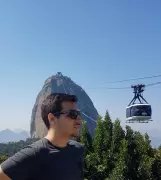– Europe/Lisbon
Room 6.2.33, Faculty of Sciences of the Universidade de Lisboa — Online

Time-frequency representations and optimal concentration inequalities
A fundamental question in mathematical analysis, with consequences to fields such as partial differential equations, mathematical physics, signal processing and many others, is that of simultaneous time-frequency concentration of signals. More specifically: given a set $Ω = I × J ⊂ \mathbb{R}^2$, how much information can be inferred about $f$ from its measurements on $I$, and measurements of its Fourier transform on $J$?
As classically known, the Uncertainty Principle prevents sharp localization, but one may hope to obtain suitably `almost-localized' signals if the underlying sets $Ω$ considered are large enough. The topic of how much of such a localization is achievable has been extensively studied by several authors, such as I. Daubechies, Y. Meyer, D. Donoho, C. Fefferman and many others, leading to the development of the theory of Wavelets and that of the Short-time Fourier transform.
In this talk, we shall highlight recent developments on concentration results for time-frequency representations, with emphasis on the cases of the Short-time Fourier and Wavelet transforms. Our main goal will be to understand the Nicola-Tilli theorem on sharp concentration for the Gabor transform, its recent stability version, and other generalizations thereof, with a focus on open problems and possible future directions.